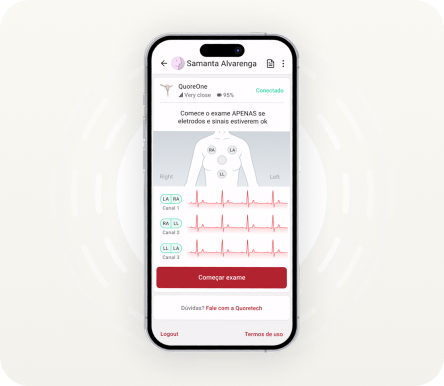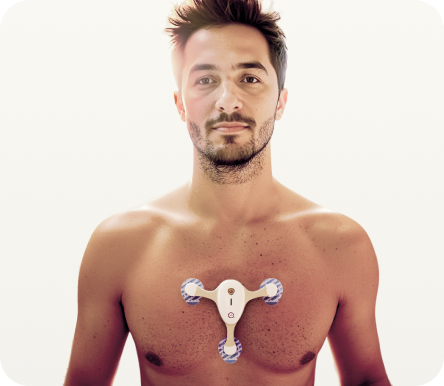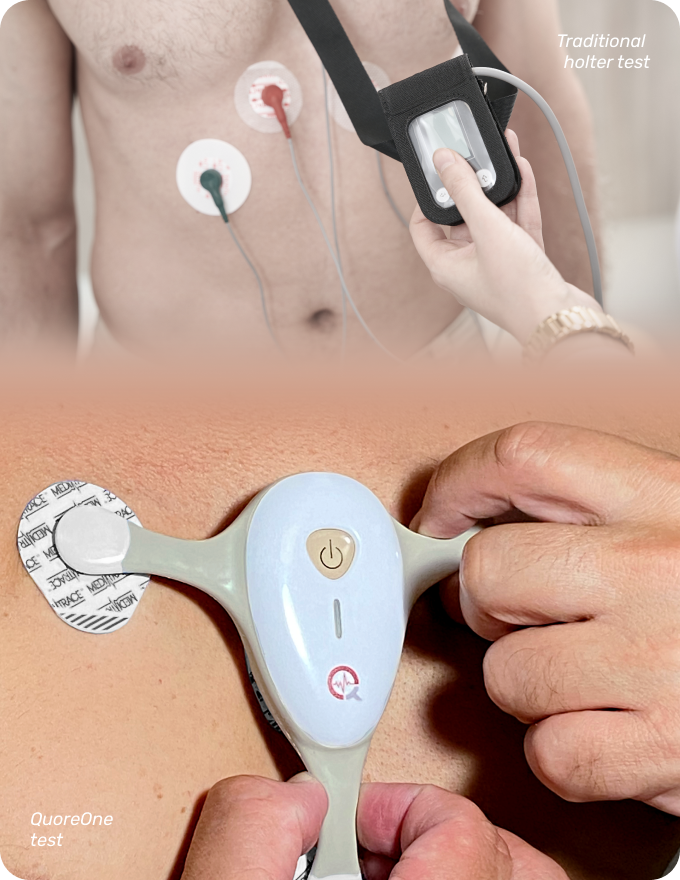Making arrhythmia diagnosis accessible to everyone.
Making arrhythmia diagnosis accessible to everyone.
Worldwide, 100 million arrhythmia tests are missed every year. 1, 2, 3

Inconvenient access to devices and arrhythmia specialists.

High costs to provide diagnostics at the point of care.

Obsolete and non-scalable methods.
Advanced cardiovascular diagnostic intelligence solution.
1.6x higher diagnostic rate 4 for severe arrhythmias.

Better outcomes
Increased diagnostic yield by more than 40% with continuous monitoring for up to 7 days. 5

Superior monitor
Continuous monitoring for up to 7 days, with 3 online leads, wireless and rechargeable.

Affordable everywhere
Advanced technology available in offices, clinics, and hospitals.
A new standard in heart rhythm monitoring.

Light and flexible

Wireless

Water-resistant

Online data transmission

AI analysis

Available in all Brazilian states
1 in 10 clinics6 already use QuoreOne in Brazil.


Today I can say that at Lapacor we have the most modern and comfortable Holter on the market. In 3 months of operation, we increased Holter exam capacity by 40% and reduced installation time by 20%.
Cristina Pedrassi - Administrator at Lapacor
References
1. Worldometer, Current World Population, Available at: [https://www.worldometers.info/world-population/], Accessed on: 25April2025
2. Karamitanha F., et al, Difference Between Various Countries in Mortality and Incidence Rate of the Atrial Fibrillation Based on Human Development Index in Worldwide: Data From Global Burden of Disease 2010-2019, Current Problems in Cardiology Volume 48, Issue 1, January 2023
3. Van Gelder I. C, et al, 2024 ESC Guidelines for the management of atrial fibrillation developed in collaboration with the European Association for Cardio-Thoracic Surgery (EACTS), European Heart Journal (2024) 00, 1-101, https://doi.org/10.1093/eurheartj/ehae176 and Risks, 1990-2022100000.
4.Known S., et al, Comparison Between the 24-hour Holter Test and 72-hour Single-Lead Electrocardiogram Monitoring With an Adhesive Patch-Type Device for Atrial Fibrillation Detection: Prospective Cohort Study, J Med Internet Res. 2022 May; 24(5): e37970. Published online 2022 May 9. doi: 10.2196/37970: 10.2196/37970.
5. Kim J. Y., et al, The efficacy of detecting arrhythmia is higher with 7-day continuous electrocardiographic patch monitoring than with 24-h Holter monitoring, Journal of Arrhythmia, Received: January 3, 2023 | Revised: April 13, 2023 | Accepted: April 20, 2023, DOI: 10.1002/joa3.12865.
6. Cadastro Nacional de Estabelecimentos de Saúde (CNES), Consulta Estabelecimentos, Name with "COR" or "CARDIO", median of establishments, Available at: [https://cnes.datasus.gov.br/], accessed on 02May2025.
7. Hospital Israelita Albert Einstein, A Comparative study of an innovative 3-lead wireless water resistant Holter system and a conventional Holter system, Available at: [https://clinicaltrials.gov/study/NCT04723355?term=Quoretech&rank=1]; Access on: 25April2025
8. Data on File, Quoretech July/21
9. Yenikomshian M., et al, Cardiac arrhythmia detection outcomes among patients monitored with the Zio patch system: a systematic literature review, Curr Med Res Opin. 2019 Oct;35(10):1659-1670. doi: 10.1080/03007995.2019.1610370. Epub 2019 May 28.
10. Leclercq C., et al, Wearables, telemedicine, and artificial intelligence in arrhythmias and heart failure: Proceedings of the European Society of Cardiology Cardiovascular Round Table, EP Europace, Volume 24, Issue 9, September 2022, Pages 1372-1383, https://doi.org/10.1093/europace/euac05
11. ROL_ANS, Available at:: [https://www.ans.gov.br/ROL-web/], Accessed on: 25April2025
12. SOBRAC, The life of a cardiac arrhythmia patient, Available at: [https://sobrac.org/publico-geral/sdrfvesfvs/], Access on: 25April2025
13. ANS, TISS Data Panel, Procedures 2024, Available at:: [https://app.powerbi.com/view?r=eyJrIjoiZGVjMDI2NjItNTUzMS00OWJkLTgwNjMtOTJmNTVlYzYwMTg0IiwidCI6IjlkYmE0ODBjLTRmYTctNDJmNC1iYmEzLTBmYjEzNzVmYmU1ZiJ9], Access on: 25April2025
14. DATASUS, AMBULATORY PRODUCTION OF THE SUS - BRAZIL - BY PLACE OF CARE, HOLTER, Available at: [http://tabnet.datasus.gov.br/cgi/tabcgi.exe?sia/cnv/qabr.def], Access on: 25April2025



